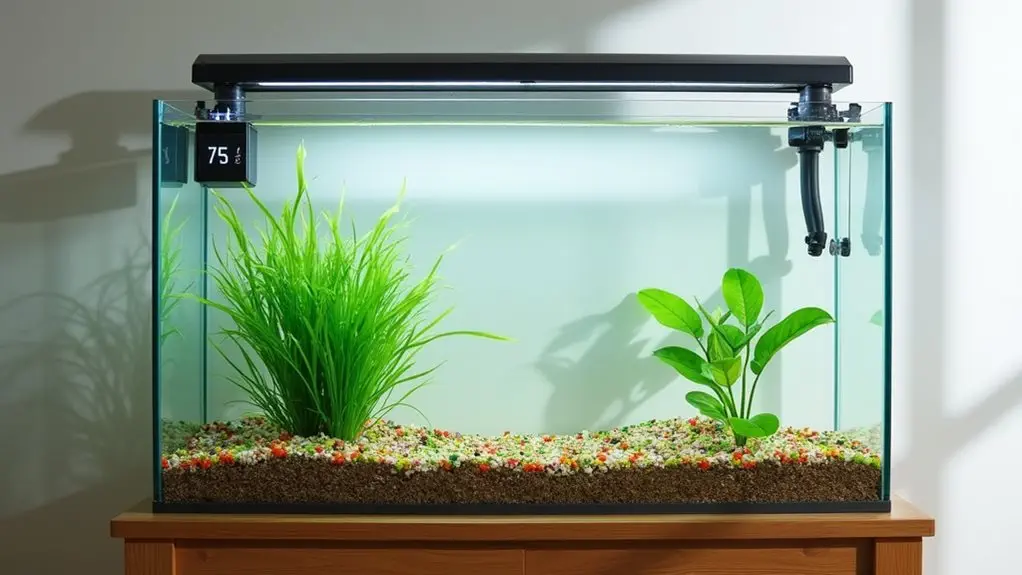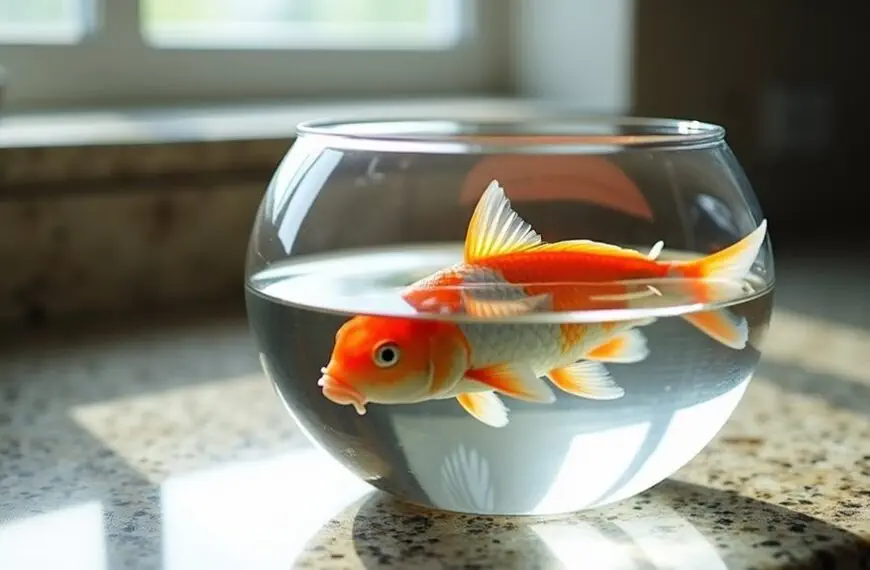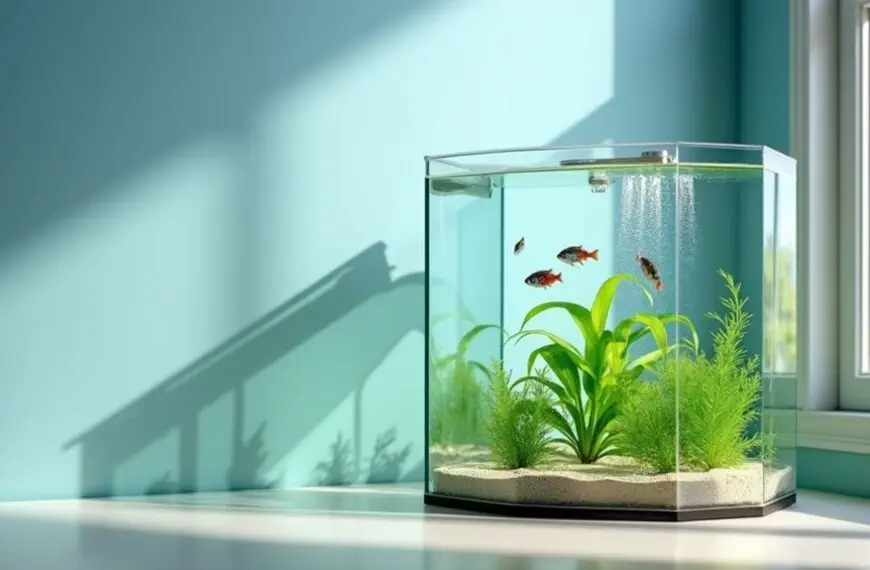You'll need to wait 4-8 weeks before adding fish to your new aquarium, and while that might seem like forever, it's essential for your future finned friends' survival. During this period, your tank goes through a process called cycling, where beneficial bacteria establish themselves to break down harmful waste products. Think of it as creating a tiny ecosystem – you wouldn't want to move into a house before the plumbing works, right? Keep the water temperature between 83-87°F, and monitor those water parameters regularly. The wait may test your patience, but there's plenty you can do to guarantee your tank becomes the perfect underwater paradise.
Contents
- 1 Understanding New Tank Setup
- 2 The Essential Waiting Period
- 3 Risks of Early Fish Addition
- 4 Tank Cycling and Water Balance
- 5 Fish Acclimation Methods
- 6 Preparing Your Tank Environment
- 7 Adding Multiple Fish Successfully
- 8 Managing Water Quality
- 9 Monitoring Fish Health
- 10 Best Time for Fish Introduction
- 11 Frequently Asked Questions
- 11.1 Can I Speed up the Tank Cycling Process Using Bottled Bacteria?
- 11.2 How Many Fish Should I Start With in a Brand-New Tank?
- 11.3 Should I Feed My Fish Immediately After Adding Them to the Tank?
- 11.4 Does Tank Placement Near Windows Affect How Soon I Can Add Fish?
- 11.5 Are Certain Fish Species Better Suited for Newly Established Tanks?
- 12 Final Thoughts
Understanding New Tank Setup
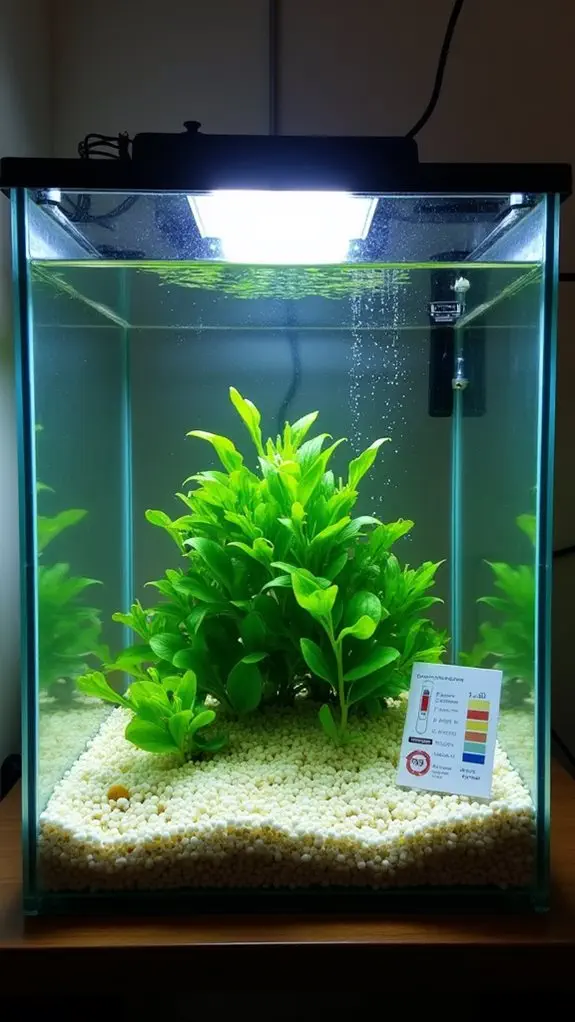
Setting up a new aquarium requires careful planning and attention to detail. Your first essential decisions involve tank location and substrate selection, which will set the foundation for your aquatic environment's success. Some initial cloudiness is normal when first setting up your tank and will gradually clear over time. The tank must undergo a complete nitrogen cycle before adding any fish to establish beneficial bacteria, which are crucial for maintaining water quality.
You'll want to place your tank away from direct sunlight, heating vents, and air conditioners to maintain stable water temperatures – trust me, your future fish will thank you!
Once you've found the perfect spot, it's time to prepare your tank's foundation. Start by thoroughly rinsing your chosen substrate (that's just a fancy word for gravel or sand) with hot water until it runs clear.
You don't want cloudy water ruining your tank's debut! When you're adding the substrate to your tank, pour it in slowly using a plate to prevent scratching the glass – it's like giving your tank a protective cushion.
The Essential Waiting Period
The essential waiting period represents three significant phases in establishing your aquarium: tank cycling, quarantine time, and fish introduction intervals.
Each phase offers vital waiting period benefits that'll help guarantee your underwater friends thrive in their new home. Think of it as preparing a five-star hotel for your finned guests – you wouldn't want them checking in before the rooms are ready! Quality equipment can make a significant difference in maintaining proper water parameters during the waiting period. Additionally, ensuring a stable cycling temperature is beneficial for optimal bacteria growth.
Larger tanks help maintain more stable water conditions during the cycling process. Here's what you'll need to time perfectly for a successful aquarium:
- Tank cycling (1-2 weeks): Your filter needs time to build up beneficial bacteria – they're like tiny housekeepers that'll keep your water clean.
- Quarantine period (4-6 weeks): This gives you time to check if your new fish are healthy and disease-free.
- Staggered fish additions (2-3 weeks between each): You'll want to add fish gradually to prevent overwhelming your tank's ecosystem.
- Monitoring and adjustment time: Keep testing water parameters until they're stable.
Understanding cycling importance can't be overstated – it's the foundation of a healthy aquarium.
While waiting might test your patience, remember that these periods aren't just suggestions – they're vital steps that'll help you avoid common newcomer mistakes and guarantee your fish's long-term health.
Risks of Early Fish Addition
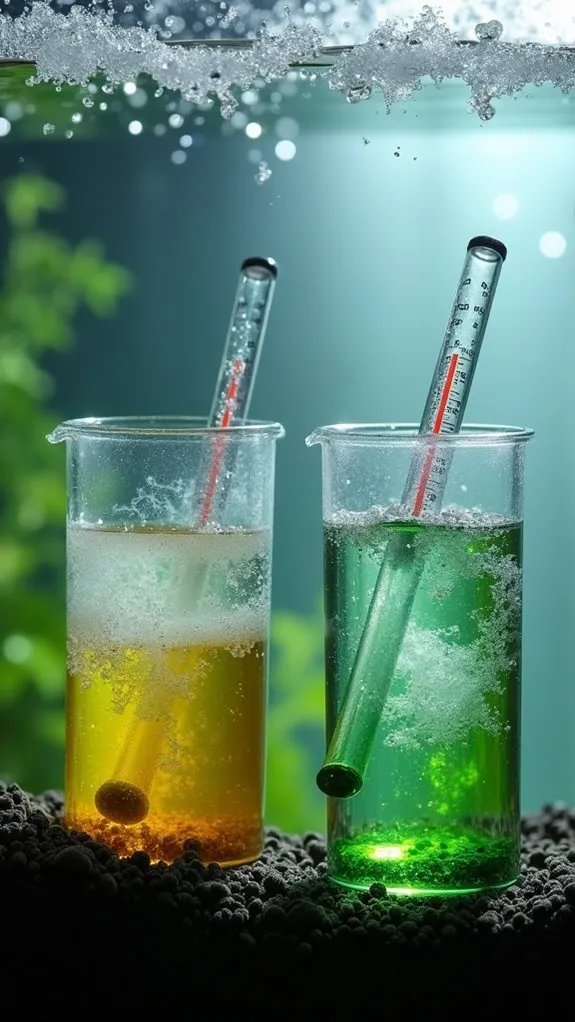
Rushing to add fish into a new aquarium can spell disaster for your underwater pets. Without proper bacterial establishment, your tank's biological filtration can't handle the waste your fish produce, leading to dangerous ammonia spikes. Cycling establishes beneficial nitrifying bacteria that convert harmful ammonia to less toxic substances, creating a stable environment for your fish. It's like inviting guests to stay at your house before you've installed the plumbing – things can get messy fast! Water conditioner treatments must be used to neutralize harmful toxins from local water facilities. Proper acclimation time of 30-60 minutes is essential when introducing new fish to prevent shock and stress.
When you add fish too quickly, you're facing serious overstocking risks that can stress and sicken your aquatic friends. Your beneficial bacteria need time to grow and multiply, typically taking 4-6 weeks to form a stable colony. During this time, monitoring water parameters is critical to ensure a healthy environment for your fish.
If you don't wait, you'll likely encounter "new tank syndrome," where ammonia and nitrite levels soar to toxic levels. You'll also need to take into account the delicate balance of environmental conditions. Sudden changes in pH, temperature, or water chemistry can shock your fish, making them more susceptible to disease.
Tank Cycling and Water Balance
Proper tank cycling serves as your foundation for a healthy aquarium ecosystem. During this essential 4-8 week process, you'll establish the nitrogen cycle by cultivating beneficial bacteria growth in your filter and substrate. Live nitrifying bacteria can be added to accelerate cycling time. Remember that using chemical ammonia removers can actually harm the cycling process.
Think of it as creating a miniature ecosystem that'll keep your future fish happy and healthy. Establishing a balanced environment is crucial to prevent ammonia toxicity later on.
You'll need to monitor your water parameters closely as the cycling process unfolds. Here's what to track:
- Ammonia levels should start high but gradually decrease to zero
- Nitrite levels will spike and then drop to zero
- Nitrate levels will begin to rise, indicating successful cycling
- pH levels should remain stable between 7.0 and 7.8
While you're waiting, maintain water temperatures between 83°F to 87°F to speed up bacteria growth.
Don't forget to perform weekly water changes of 10-20% to help manage ammonia levels. You might notice some algae appearing – that's actually a good sign! It often indicates that your cycle is progressing nicely.
Fish Acclimation Methods
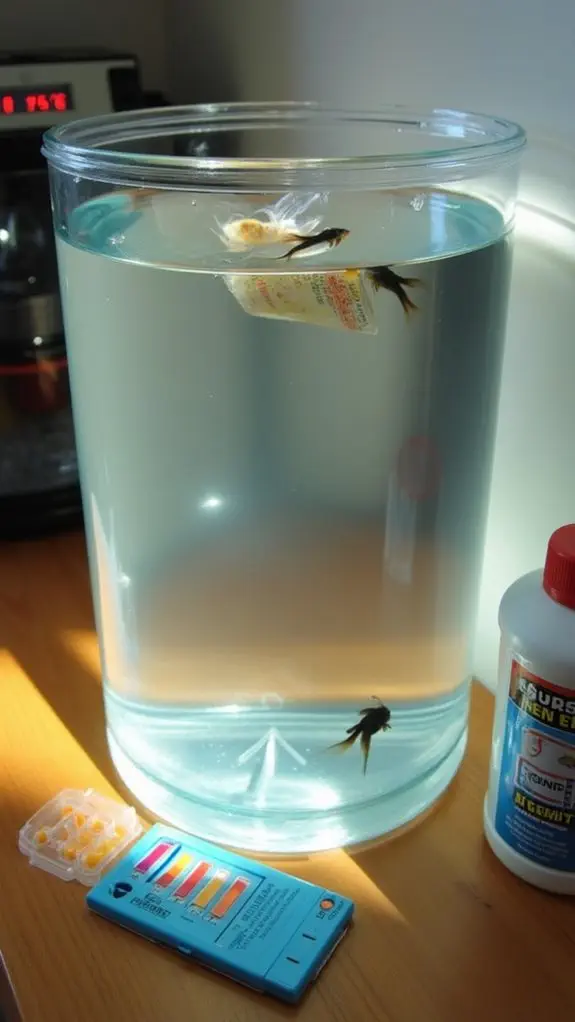
Success in introducing new fish to your aquarium depends heavily on proper acclimation techniques. You'll find two main methods that work wonderfully: the floating method and the drip method. Each has its merits, and you'll want to choose the one that best suits your setup and comfort level.
The floating method's pretty straightforward – you'll float the sealed bag in your tank for about 15-20 minutes, then gradually add tank water to the bag. It's like introducing your fish to their new home through a cozy waiting room! An important step is to turn off the aquarium lights to help minimize stress during this process. For sensitive species like discus and fancy plecos, extended acclimation time may be necessary. Keeping an eye on water quality in the tank is crucial during acclimation to ensure a stress-free transition.
The drip method's a bit more precise, using a special kit to slowly introduce your tank water to your fish at 2-4 drops per second.
Whatever acclimation technique you choose, plan for about 30 minutes to an hour of acclimation duration. You'll want to keep those tank lights off during this time – think of it as giving your fish some privacy while they adjust to their new digs!
Remember to monitor your little swimmers for any signs of stress, and don't forget to quarantine them for a couple of weeks before introducing them to their tank mates.
Preparing Your Tank Environment
A well-prepared tank environment serves as the foundation for your fish's health and happiness. Before you rush to add those colorful swimmers, you'll need to focus on creating the perfect underwater home.
Tank aesthetics aren't just about making things look pretty – proper setup guarantees your fish will thrive in their new environment.
Here's what you'll need to do to prepare your aquarium:
- Choose the perfect spot for your tank, away from direct sunlight, windows, and temperature fluctuations – your fish won't appreciate a tank that feels like a greenhouse!
- Rinse your substrate selection and decorations thoroughly with distilled water to remove any unwanted chemicals or dust.
- Set up your equipment properly, including filters, heaters, and aerators – think of it as creating a cozy apartment with all the amenities.
- Condition your tap water to neutralize harmful chemicals, and let the tank cycle for at least 24-48 hours to establish the nitrogen cycle, which is crucial for maintaining water quality.
Remember to test your water quality regularly and make adjustments as needed.
While waiting might test your patience, it's worth taking the time to create a stable, healthy environment that your fish will love calling home.
Adding Multiple Fish Successfully
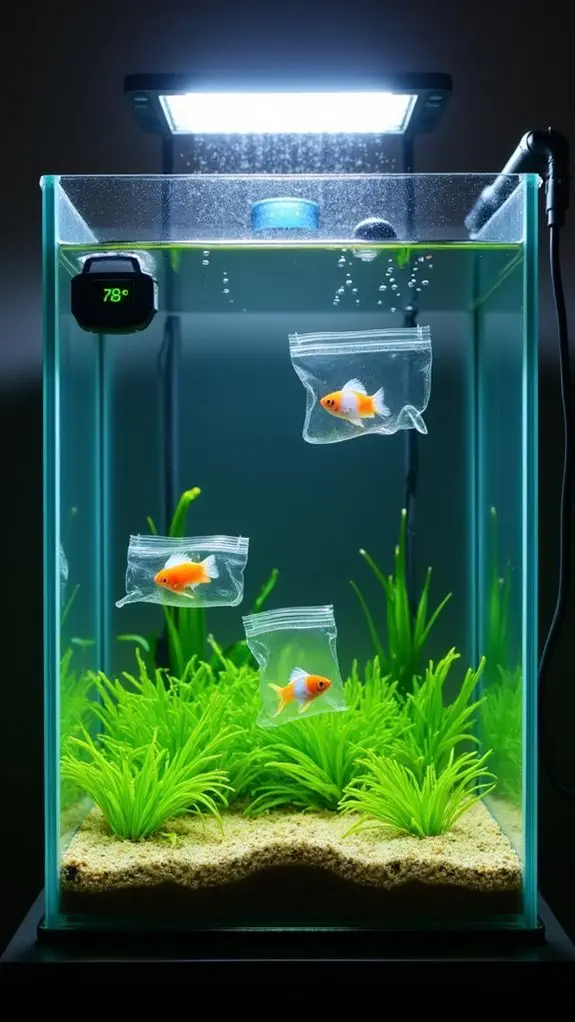
Now that you've prepared the perfect aquarium environment, the next big challenge lies in introducing multiple fish to their new home.
When it comes to adding fish, patience truly is a virtue – you'll want to take things slow and steady to guarantee everyone's happiness and health.
Start by introducing hardier species first, and if you're planning to keep schooling species, add them in small groups rather than all at once.
This gradual introduction helps your beneficial bacteria keep up with the increasing waste load while preventing stress on both new and existing fish. It's essential to ensure that the tank is kept at ideal water temperature for the best fishkeeping experience.
You'll want to wait about two weeks between adding new groups, giving you plenty of time to monitor water quality and fish behavior.
Managing Water Quality
Managing proper water quality involves four critical components: conditioning, pH balance, cycling, and regular maintenance.
You'll need to master these elements to create a healthy environment for your fish. Think of it as creating the perfect home – you wouldn't want to live in a house full of toxic chemicals, and neither do your finned friends!
Here's what you'll need to focus on for ideal water quality:
- Start with a quality water conditioner to neutralize harmful chemicals like chlorine and heavy metals in your tap water. It's your first line of defense!
- Monitor pH levels weekly through regular testing, aiming for 6.5-7.5 for most freshwater fish. Different species have different needs, so research your specific fish.
- Allow proper cycling time (2-6 weeks) for beneficial bacteria to establish themselves and create a natural filtration system. This process is vital to breaking down waste and maintaining optimal water conditions, ensuring low levels of harmful toxins.
- Maintain your tank with weekly 10-20% water changes, substrate cleaning, and filter maintenance to manage nitrate levels and remove waste.
Monitoring Fish Health
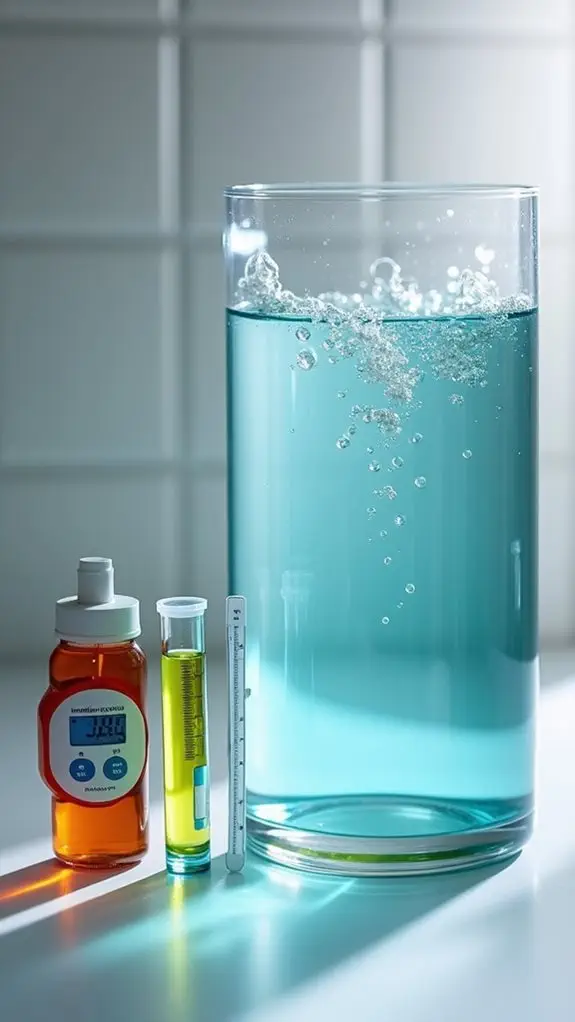
Proper water quality sets the foundation, but your fish's health needs constant attention too.
You'll want to become familiar with normal fish behavior so you can quickly spot when something's not right. Think of yourself as your fish's personal health detective!
Keep an eye out for key health indicators like bright, clear coloring and active swimming patterns. If you notice your fish looking dull, hiding in corners, or "spazzing" by rubbing against surfaces, they might be telling you something's wrong.
Just like us on a bad day, fish show signs when they're not feeling their best – from cloudy eyes to missing scales.
Don't panic if you see unusual behavior in the first week – your fish need 3-7 days to adjust to their new home.
However, if you notice aggressive behavior, loss of appetite, or labored breathing, it's time to take action. Be especially watchful during feeding times; healthy fish are usually enthusiastic eaters. Regularly testing for key water parameters can also help identify underlying issues that may be affecting your fish's health.
Remember to quarantine new arrivals before adding them to your main tank – it's like a fish version of a two-week isolation period!
Best Time for Fish Introduction
Timing your fish introduction perfectly can make or break your aquarium's success. You'll want to carefully consider both the time of day and overall conditions before adding your new aquatic friends to their forever home. The best introduction timing typically happens during evening hours when lighting is dim, helping to reduce stress and promote natural fish behavior.
Here are the key steps to guarantee a smooth changeover:
- Wait 24-48 hours after tank setup to allow water parameters to stabilize.
- Choose evening hours, about 1-2 hours before lights out.
- Feed existing fish first to minimize competition.
- Use an acclimation box for gradually introducing new residents.
You'll notice that fish behavior is much calmer during low-light conditions, making evening introductions ideal. It's like moving into a new home – you'd want some quiet time to settle in, right?
Remember to monitor your new fish closely during their first few days, watching for signs of stress or aggression. If you're planning to add multiple fish, space out your introductions over several weeks to maintain harmony in your underwater community. Additionally, ensuring that your water parameters are within the safe ranges for ammonia and nitrite is crucial for the health of your new fish in their new environment.
This patient approach will reward you with healthy, happy fish that thrive in their new environment.
Frequently Asked Questions
Can I Speed up the Tank Cycling Process Using Bottled Bacteria?
You shouldn't rely on bottled bacteria effectiveness for cycling speed enhancement. Tests show these products often don't work as claimed. Instead, use proven methods like seeding from established tanks or fishless cycling with ammonia.
How Many Fish Should I Start With in a Brand-New Tank?
You'll want to start with just 2-3 hardy fish, around 25% of your planned tank stocking. Choose compatible species like tetras or danios, and monitor water parameters before adding more fish gradually.
Should I Feed My Fish Immediately After Adding Them to the Tank?
Don't feed your fish right away after adding them. Wait 24-48 hours to establish a feeding schedule, as they need time to reduce stress and acclimate to their new environment before they'll eat properly.
Does Tank Placement Near Windows Affect How Soon I Can Add Fish?
While you can add fish on schedule, placing your tank near windows isn't ideal. The light exposure and temperature fluctuations will stress your fish and promote algae growth. Consider a more stable location instead.
Are Certain Fish Species Better Suited for Newly Established Tanks?
You'll find hardy species like rasboras, platies, and tetras are most compatible species for new tanks. They're adaptable to less-than-ideal conditions and cope better with the establishing ecosystem as beneficial bacteria develop.
Final Thoughts
You'll find that patience is truly the key to a successful aquarium setup. While you're excited to add fish to your new tank, waiting 2-4 weeks for proper cycling will reward you with healthier, happier fish that'll thrive in their new home. Keep testing your water parameters, and when they're stable, you can start adding your aquatic friends. Remember, rushing this process often leads to disappointment, but doing it right means years of fish-keeping enjoyment.

